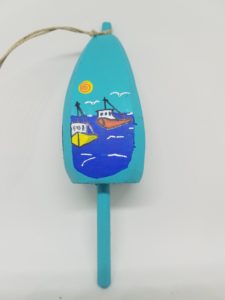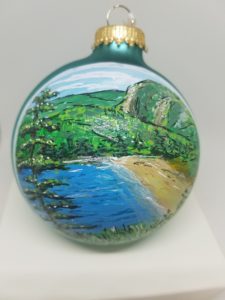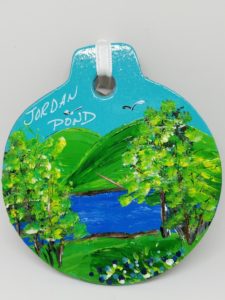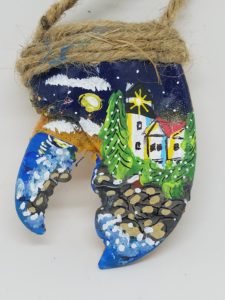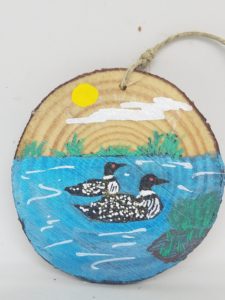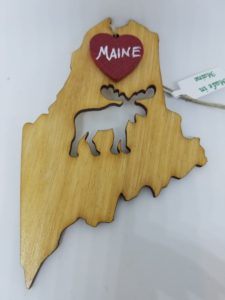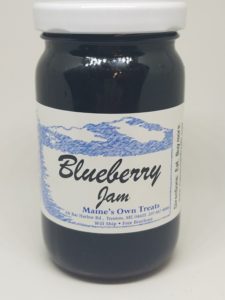Bar Harbor / Maine Information
If you have ever wondered about Lobsters, Moose, Acadia National Park or those quirky little puffins in Maine, you are in the right place! We have gathered some interesting facts about many themes in Maine and New England. Many of these themes serve as an inspiration in to the artwork and one of a kind handcrafted gifts offered at The Christmas Vacation Shop and we hope you enjoy the information listed below as well as your shopping experience online here at www.christmasvacationshopgiftscom!
Lobster Lobster Buoys Lobster Traps Lobster Boats 100 Lobster Facts Blueberries Loons Lighthouses Moose Puffins Whales
Acadia National Park Acadia Activities Bass Harbor Lighthouse Beehive Trail Cadillac Mountain
Jordan Pond Otter Cliffs Park Loop Road Precipice Trail Sand Beach Thunderhole
Lobster, Ayuh!
Lobsters were once considered the poor man’s chicken and often fed to pigs, servants, laborers because it was plentiful and cheap. It most certainly was not consumed by the more privileged society and actually considered an embarrassment if caught being eaten by “the elite”. Lobsters can grow up to 4 feet long and weigh as much as 40 pounds and may live as long as 100 years. They have a crusher claw and a pincher claw. Those having a crusher claw on the right are considered “right-handed,” and the others are “left-handed.” Lobsters grow by molting/shedding their shells each year. Just after they molt, they are soft and fragile until their new shell has hardened and known as soft shell or “shedders.” After their new shell hardens, they are known as hard shell lobsters. Soft-shelled lobster is considered to have sweeter, more tender meat. Lobsters have teeth in their stomachs and a “voice”; a crackly noise some people compare to violins. It’s a myth that lobsters scream when you put them in hot water – they have no lungs and no vocal cords. A lobster has no cerebral cortex, the area of the human brain that gives the perception of pain, and their brains are no bigger than the tip of a ball-point pen! One of the most extraordinary abilities that lobsters possess is called reflex amputation. The lobster will throw or release an appendage when stimulated by shock, fear or injury. It will later regenerate this part. Adult lobsters cannot swim forward. Lobsters can swim forward only during the end of their juvenile stage. The largest lobster ever caught in Maine measured 36 in. from nose to tail. The largest ever caught weighed just over 44 pounds; it was caught in 1977, off Nova Scotia and had a total length of 3.5 feet.
Lobster Traps
Lobster Traps come in different shapes and sizes. Some are built out of wood, either rounded or rectangular. Some are made of heavy, plastic colored wiring. The design stays the same for all, a netting for the entrance of the trap leading to a metal circle through which the lobster comes when it tries to get that bait. There is another funnel-shaped piece of netting that leads to a second part of the trap where the lobster gets caught, then it’s hauled up. Each trap is connected by rope to a lobster buoy. These buoys come in many color combinations. Each lobsterman has his own color pattern, which helps him find his own traps.
Lobster Buoys
The use of the lobster buoy is important in lobster fishing. It marks the place a fisherman has set a trap and comes attached by a line or rope, known as a potwarp, to a triple, pair or single group of lobster traps on the ocean’s bottom.Originally, lobster buoys were created out of wood, mostly black cedar before they were painted using a number of colors and/or patterns unique to a person owning them. Today, though, most lobster buoys are Styrofoam made, each of them carrying the initials of the lobsterman as well as the lobster number. Whether plastic, Styrofoam or wooden, buoys are a beautiful sight and very important in lobster fishing.
Lobster Boats
Lobster Boats range from oar boats, outboard or inboard gas power or inboard diesel power. Most all boats with inboard and outboard power have a type of powered hauler to bring up the trap from the ocean bottom. These days, lobstermen use a depth sounder, GPS, CB Radio and/or VHF marine radio telephone that are considered necessary. Larger boats usually have radar to make it possible to fish during poor visibility.
Acadia National Park
Acadia National Park comprises 47,000 acres of land on Mount Desert Island, Isle au Haut and the Schoodic Peninsula—is the only national park in Maine. It is located in the area of Downeast Maine, Mount Desert Island, Acadia Maine. On, MDI you can walk, hike, bike, and drive the national park, making sure not to miss the Park Loop Road, a 27 mile loop that encompasses many beautiful areas including its rocky coastline, mountains, forests, ponds, marshlands and fields. You can also see the diversity of the state’s native species, ranging from mollusks and mammals to raptors and reptiles. You and your family can watch for whales, seals, moose, foxes, peregrine falcons, herons, salamanders and toads as you explore the park.
Sand Beach
Sand Beach, in Acadia National Park, is nestled in a small inlet between the granite mountains and rocky shores of Mount Desert Island. This gorgeous 290 yard long beach is one of the most popular points of interest on the island. The thousands of years of pounding surf created a beach that is largely comprised of unique sand of shell fragments. The ocean temperature rarely exceeds 55 degrees in the summer and there is approximately one half cup of salt per gallon of ocean water. Access to Sand Beach is provided via the Park Loop Road just after the park fee entrance station on the northeastern side of the island. A lifeguard is on duty from Memorial Day through Labor Day. There is a very nice oceanside trail, accessed from the upper parking lot, that follows the shore’s edge past Thunder Hole and arrives at Otter Cliff to the south. This is well worth the trek.
Thunderhole
Nothing symbolizes the power of Acadia National Park as much as Thunder Hole does. When the right size wave rolls into the naturally formed inlet, a deep thunderous sound emanates. The cause is a small cavern formed low, just beneath the surface of the water. When the wave pulls back just before lunging forward, it dips the water just below the ceiling of the cavern allowing air to enter. When the wave arrives full force, it collides with the air, forcing it out, resulting in a sound like distant thunder. Water may splash as high as 40 feet with a roar! This is a beautiful spot to view some of the most striking features within Acadia. Northward is Sand Beach and the Great Head to the right. Southward is the majestic 110 foot high Otter Cliff, one of the highest headlands north of Rio de Janeiro.
Otter Cliffs
One of the most spectacular sights along the North Atlantic Seaboard is Otter Cliff in Acadia National Park. At 110 feet high, it is one of the highest headlands north of Rio de Janeiro. Located on Mount Desert Island, in Maine, it is just .7 miles after Thunder Hole next to the Park Loop Road. An ocean path parallels this section of road from Sand Beach to the north, past Thunder Hole, arriving at Otter Cliff, providing numerous vantage points for spectacular views. There is a bell buoy located off shore that marks the rock formation called the “Spindle.” Centuries ago, while sailing nearby at high tide, the explorer Samuel Champlain noticed smoke rising from a Native American’s encampment. After sailing closer for a better view, his ship struck the “Spindle” requiring the ship to seek refuge in Otter Cove for safety and repairs.
Jordan Pond
The Jordan Pond and the Jordan Pond House Restaurant are a famous combination in Acadia National Park. It is difficult to separate them. A late 1800’s version of the restaurant first established the tradition of having tea & popovers on the lawn while overlooking Jordan Pond and the North and South Bubble Mountains. The original building was destroyed by fire in 1979 and was later rebuilt with the help of private funds.
Jordan Pond Specs:
Maximum water depth: 150 feet
Pets: Not allowed in water Boating: Maximum 10 horsepower motors
Special: No swimming, windsurfing, SCUBA, or boating allowed within 1,000 ft of the water intake Fish: Landlocked salmon, lake trout
Precipice Trail
The Precipice is part of the east face of Champlain Mountain. The Precipice Trail is the most challenging and well known hiking trail in
Acadia National Park with an exposed and almost vertical 1,000 foot climb. It is designated as “strenuous” and is only recommended for physically fit and experienced hikers who have no fear of heights. The Precipice happens to be home to many endangered peregrine falcons. Consequently, the hiking trail can be closed from late spring through mid-August. During this time (Monday – Friday), there often is a Park Naturalist leading observations and discussions in the parking area at the base of the cliffs. Champlain Mountain Specs: Elevation: 1,058 feet (323 m) Previous name: Newport
Beehive Trail
The mountain that you will notice from the parking area of Sand Beach is likely The Beehive. Look closely and you might see people climbing toward the summit.At a respectable 520 feet, The Beehive rises proudly above the terrain near Sand Beach on the eastern side of Mount Desert Island. As a matter of fact, when you arrive at the Sand Beach parking lot and look back towards the entrance, The Beehive is the dominant geological feature. Look closely and you will likely see people climbing it’s face or even standing on its summit. The Beehive Trail (as it is called) is rated as “Strenuous” and is approximately 0.8 miles/1.3 km long. Hiking is through woods to exposed cliffs. There are iron rungs on the ledges. The Beehive Trail entrance is located between the park entrance fee station on the Park Loop Road and Sand Beach, on the eastern shore of Mount Desert Island.
Park Loop Road
The primary avenue for navigating through Acadia National Park on Mount Desert Island is the Park Loop Road. This 27 mile road begins at the Hulls Cove Visitor Center (near Route 3 on the northern side of the island) and connects the Park’s lakes, mountains, forests, and rocky coast. Construction of the Park Loop Road began in 1922 and continued through the 1950’s. It was partially financed by John D. Rockefeller, Jr., who also was the father of the Carriage Roads. Much of the road is one way. This continues all the way to Wildwood Stables where it begins a two way section that passes Jordan Pond northward where it arrives at the entrance to the Cadillac Mountain summit road. There are several parking areas and pullover points along the way. Take your time and enjoy the sights, stopping often. Watch out for wildlife, particularly in the morning.
Cadillac Mountain
Cadillac Mountain, at 1,530 feet, is the tallest mountain on Mount Desert Island and the highest point along the North Atlantic seaboard. From October 7 through March 6 of each year, it is the first place to view a sunrise in the United States. Millions of years ago, the earth’s tectonic and volcanic forces pushed the land upward to form the mountains on the island. Then, during ice ages that followed, huge 1 – 2 mile high and slow moving glaciers sheared off the top leaving the rounded off appearance we see today. Largely composed of pink granite, it is covered with spruce and pitch pine forests, tiny sub alpine plants (such as cinquefoil), short gnarled trees, wild blueberries, and boulders of all sizes and shapes. The Park Loop Road winds approximately 3.5 miles to the summit and provides several key spots along the way where you can stop and take in the spectacular panoramic views. On the northwestern side you will see Eagle Lake, Western Bay, and further inland. To the south, you will see the Cranberry Islands. To the northeast lies Bar Harbor, the Porcupine Islands, Bar Island, and in the distance, Schoodic Peninsula on the mainland.
Bass Harbor Lighthouse
Marking the entrance to Bass Harbor as well as Blue Hill Bay, the Bass Harbor Lighthouse on Mount Desert Island in Tremont, Maine was built in 1858. A fog bell and tower were added in 1876. The lighthouse, situated on Acadia National Park land, stands 56 feet above mean high water and is accessible by car off of State Route 102A. The keeper’s house is currently being used for Coast Guard housing. As you arrive in the parking area, you will note a walking path to the left. This leads to a stairway that will take you down the face of the cliff to an oceanside observation area. The path to the right of the building leads to a vantage point that provides a panoramic view of the ocean.
Bass Harbor Head Lighthouse Specs:
Established: 1858
Construction: Brick
Tower height: 32 feet
Focal plane height: 56 feet
Optic material: Fourth order Fresnel (1902)
Loons
Common Loons are large, diving waterbirds with rounded heads and dagger-like bills. They have long bodies and short tails that are usually not visible. In flight, they look stretched out, with a long, flat body and long neck and bill. Their feet stick out beyond the tail (unlike ducks and cormorants), looking like wedges. Common Loons are stealthy divers, submerging without a splash to catch fish. Pairs and groups often call to each other at night. In flight, notice their shallow wingbeats and unwavering, bee-lined flight path. Common Loons breed on quiet, remote freshwater lakes of the northern U.S. and Canada, and they are sensitive to human disturbance. In winter and during migration, look for them on lakes, rivers, estuaries, and coastlines.
Puffins
Puffins are a cute, quirky bird. Atlantic puffins have penguin-like coloring but they sport a colorful beak that has led some to dub them the “sea parrot.” The beak fades to a drab gray during the winter and blooms with color again in the spring—suggesting that it may be attractive to potential mates. These birds live most of their lives at sea, resting on the waves when not swimming. They are excellent swimmers that use their wings to stroke underwater with a flying motion. In the air, puffins are surprisingly fleet flyers. By flapping their wings up to 400 times per minute they can reach speeds of 55 miles an hour. Atlantic puffins land on North Atlantic seacoasts and islands to form breeding colonies each spring and summer. The birds often select precipitous, rocky cliff tops to build their nests, which they line with feathers or grass. Females lay a single egg, and both parents take turns incubating it. When a chick hatches, its parents take turns feeding it by carrying small fish back to the nest in their relatively spacious bills. Puffin couples often reunite at the same burrow site each year.
Whales
The Gulf of Maine and the region that encompasses Acadia National Park is rich with marine life. Among the marine life are Finback, Humpback and Minke whales. On a whale watching tour, you will be able to see these and possibly be able to view various species of sharks and Giant Tuna. There are all kinds of incredible creatures to encounter while cruising the area.
Moose
Moose are the largest of all the deer species. Males are immediately recognizable by their huge antlers, which can spread 6 feet from end to end. Moose have long faces and muzzles that dangle over their chins. A flap of skin known as a bell sways beneath each moose’s throat. Moose are so tall that they prefer to browse higher grasses and shrubs because lowering their heads to ground level can be difficult. Moose are at home in the water and, despite their staggering bulk, are good swimmers. They have been seen paddling several miles at a time, and will even submerge completely, staying under for 30 seconds or more. Moose are similarly nimble on land. They can run up to 35 miles an hour over short distances, and trot steadily at 20 miles an hour. Males, called bulls, bellow loudly to attract mates each September and October. The usually solitary bulls may come together at this time to battle with their antlers for mating supremacy. After mating, the two sexes go their separate ways until the following year. Though they may occasionally feed in the same grounds, they tend to ignore each other. Females give birth to one or two calves in the spring—each weighing some 30 pounds. These calves grow quickly and can outrun a person by the time they are just five days old. Young moose stay with their mothers until the following mating season.
Lighthouses in Downeast Maine
A single lighthouse stands on Mount Desert Island: Bass Harbor Head Light. Located at the southwestern reach of Acadia National Park in Bass Harbor, the light guards the southern entrance of Blue Hill Bay and warns against Bass Harbor Bar. The light is still fully operational, signaling an occulting red four seconds—three red flashes, one second of darkness. Built in 1858, the lighthouse sits high atop a rugged granite shoreline, making it one of the most scenic in New England. Today, the US Coast Guard mans the station, listed on the National Historic Register. Visitors may tour the grounds at Bass Harbor Head, but not the lighthouse itself. Five other nearby lighthouses with island settings from Blue Hill Bay to Frenchman Bay signal mariners with flashing lights and fog blasts to keep them safe in foul weather. Two of them—the Mount Desert Rock Light and the Great Duck Island Light—are owned by the College of the Atlantic, where students study whales and nesting seabirds. The other three are Bear Island Light, Egg Rock Light, and Isle au Haut Light. The oldest light in the area, Baker Island Light (1828), along with Winter Harbor Light, have been replaced with lighted offshore buoys. All these great old lighthouses can be viewed and photographed on boat tours that reveal their incredible and storied histories.
Blueberries
Maine is the largest producer of wild blueberries in the world, and they are grown on 60,000 acres. Maine Blueberries were some of the first plants to appear in Maine over 10 thousand years ago! It has been recorded that when the glaciers over Maine receded, some of the first plants to appear were wild blueberry bushes. 1,000 years ago, Native Americans discovered that blueberries were not only tasty but healthy. The Native Americans began the practice of burning the fields to kill off unwanted insects and weeds, maximizing the quality and growth of their blueberry fields. There are 6.5 MILLION varieties of blueberries, 6.5 MILLION!! It is that diversity of blueberries that gives the wonderful flavor to wild blueberries, it’s actually a complex mixture of flavors.
Activities
Acadia National Park is a beautiful national park, encompassing 47,000 acres of land on Mount Desert Island, Isle au Haut and the Schoodic Peninsula. Here, and Bar Harbor, there are so many things to do. From shopping to enjoying the great food, the activities for young and young at heart are vast. You can do activities on your own, with a tour, or by renting what you need. The Acadia National Park Visitor Center offers an abundance of helpful information and we offer you ornaments to commemorate those activities. Hike, Walk, Bike, Kayak, Canoe, Swim, Run, Ride and Enjoy beautiful Acadia National Park, and remember your warm vacation memories with an ornament from The Christmas Vacation Shop!
More Lobster Information
- Lobsters were once considered the poor man’s chicken. In Colonial times, it was fed to pigs and goats and only eaten by paupers.
- Lobsters aren’t red. They turn red when cooked, but in nature they can be green or yellow or even bright blue.
- Lobster fishermen throw back lobsters that are too small and lobsters that are too big. The small ones need to grow, while the large ones add vigor to the gene pool.
- In Maine, a lobster’s body must be at least 3 1/4 inches to keep, and can’t be over 5 inches.
- When lobsters mate, the eggs aren’t fertilized right away. The female carries the male’s sperm and chooses when to fertilize her eggs.
- Lobsters shed their shells, or molt.
- A female lobster can only mate just after she has molted.
- Lobsters can swim forward and backward. When they’re alarmed, they scoot away in reverse by rapidly curling and uncurling their tails.
- Because its nervous system is similar to that of grasshoppers and ants, lobsters are sometimes called “bugs.”
- When food is scarce, lobsters can turn cannibal and dine on smaller lobsters.
- Lobsters reproduce by laying lobster eggs. The eggs are carried by the female until they’re ready to hatch.
- Lobster eggs are called roe, just like fish eggs.
- Former President and First Lady George and Barbara Bush loved to eat lobster served up fresh at Mable’s restaurant in Kennebunkport, Maine.
- Slaves sometimes dined like kings, often eating lobster because it was plentiful and cheap.
- Maine lobsters are clawed lobsters, and have large, meaty claws.
- Spiny Caribbean lobsters have no claws and are sold mainly for their tails.
- Besides American lobsters, people also enjoy European lobsters, Spiny lobsters, scampi, and crayfish.
- Lobsters are usually caught in an underwater trap called a “lobster pot,” baited with dead fish.
- Lobsters usually feed on bottom dwellers like clams, snails, and crabs.
- Lobsters live in the murk and mud at the bottom of the ocean.
- Lobsters can grow up to four feet long and weigh as much as 40 pounds.
- It is believed that lobsters can live as long as 100 years.
- Lobsters have a crusher claw and a pincer claw; some lobsters have the crusher claw on the right side and others have it on the left.
- Native Americans ate lobsters after wrapping them in seaweed and baking them over hot rocks.
- Native Americans also used lobster as bait and to fertilize their crops.
- Lobster meat is a great source of protein, providing 28 grams of protein per cup.
- Lobsters are a great source of heart-healthy omega-3 fatty acids.
- If you hold the butter, lobsters aren’t fattening. Three and a half ounces only have 96 calories and about two grams of fat.
- Lobsters are considered marine crustaceans along with shrimp, krill, and barnacles.
- The American lobster, found in the Atlantic Ocean, bears the scientific name Homarus americanus.
- Lobsters were once so plentiful that after a storm they would wash ashore in deep piles.
- Lobsters were originally gathered by hand. It wasn’t until the mid-19th century that lobster trapping became popular.
- Soft-shelled lobster is considered to have sweeter, more tender meat.
- A soft-shelled lobster is one that has just molted and is in a growing phase.
- Soft-shelled lobsters are called “shedders.”
- Most soft-shelled lobsters are caught from July to October.
- Hard-shelled lobsters have darker claws than the soft-shelled ones.
- Since striped bass have no teeth, they swallow lobsters whole, but only the tiny ones.
- Even full-grown lobsters can fall prey to codfish and the occasional octopus.
- You can catch lobsters by hand, just be sure to wear heavy-duty gloves.
- Lobsters have poor eyesight, but have highly developed senses of smell and taste.
- It’s not illegal to hunt lobsters at night with a flashlight, but the limit you can take is seven.
- Lobsters can be grown on farms.
- Lobster blood is not red like ours; it’s clear.
- When cooked, lobster blood turns into a whitish gel.
- A lobster will, quite literally, drown in fresh water.
- Lobsters have teeth in their stomachs.
- The lobster’s voice is a crackly noise some people compare to violins.
- It’s a myth that lobsters scream when you put them in hot water – they have no lungs and no vocal cords.
- A one-pound lobster should be cooked for about 15 minutes.
- Lobster steamed in beer is delicious. A pilsner or lager is the best choice.
- Maine is famous for producing the most lobsters, and, some would claim, the best.
- Most of the hundreds of regulations concerning lobster fishing apply to commercial fishermen.
- In some states you need a saltwater fishing license to catch lobsters; in Hawaii, no license is required unless you want to sell your catch.
- A residential license in Maryland allows you to use two lobster pots to trap lobsters.
- New fishermen sometimes have to wait for someone else to retire before they can get their own commercial lobster license.
- Some states allow commercial fisherman to use as many as 800 lobster pots.
- The design of the lobster pot has not changed much in the last 200 years.
- Each year nearly $300 million worth of lobster is harvested in the U.S.
- Maine requires lobstermen to complete a two-year apprenticeship before they can captain their own boat.
- Apprentice lobstermen can be on a waiting list for 10 years before they get their own license.
- Lobstermen swear a lot! Nearly as much as truck drivers.
- It is illegal to boil lobsters in some places, such as the village of Reggio Emilia in Italy.
- Grilled lobster tails are a true delicacy.
- There is meat in lobster legs. Bite down hard and you can suck it out.
- Lobsters are the original pea brains. Their brains are no bigger than the tip of a ball-point pen!
- The black line you see on the lobster’s tail is unfertilized eggs; you can eat them.
- The tomalley is not the lobster’s liver, it’s part of the digestive tract.
- The tomalley turns green when cooked; some people considered it a delicacy.
- You can buy live lobsters for saltwater fish tanks from an aquarium supplier.
- They’re not very friendly, but some people do keep lobsters as pets.
- Larry the Lobster is the lifeguard on SpongeBob SquarePants.
- A lobster’s claws are strong. A very large lobster could break your finger.
- Lobsters use their three pairs of antennas as sensors.
- Once you bait your lobster traps, you can check them the next morning.
- It’s a felony to rob someone else’s lobster pots.
- Lots of things get caught in lobster traps: cod, flounder, mackerel, even Coke cans.
- White fish is a good bait for lobster pots.
- Some lobstermen bait their pots with artificial bait cakes.
- Lobster traps have biodegradable doors, insuring that an abandoned trap doesn’t turn into a lobster death sentence.
- Lobsters are nocturnal, so it’s best to hunt them at night.
- Clawed lobsters like to hide in rocky crevices.
- Spiny lobsters can be found on rocky reefs.
- Most Maine lobsters are caught between June and December.
- There are around 6,000 licensed lobstermen in Maine.
- Maine lobstermen have caught over 100 million pounds of lobster annually since 2011.
- In Maine, lobster landings totaled 127,808,436 pounds in 2013, the highest amount since the Department of Marine Resources began keeping records. [Update: preliminary numbers indicate 2016’s catch to be a record-breaking 130,844,773 pounds!]
- Lobstermen are very territorial because if someone else is hunting in their area, the traps can get tangled.
- A crewman on a lobster boat makes about $50,000 a year.
- Boat owners make a lot more than crewmen, but must invest a lot more as well.
- A lobster fisherman needs to catch about 150 pounds of lobster a day just to cover the cost of bait and gas.
- The lobsterman’s day usually starts at 4:30 am and can go until dark.
- Some people consider lobster an aphrodisiac.
- People were once ashamed to eat lobsters because it was considered a poor man’s food.
- New England is one of the best places to hunt lobster because its rocky shores give them lots of places to hide.
- Female lobsters carry their eggs with their swimmerets, which are abdominal appendages.
- Depending on how warm the water is, lobsters will carry their eggs for up to a year.
- Only .1 percent of a lobster’s eggs will live more than six weeks.
- Lobstermen cut a notch in the tale of a female lobster to tell other fishermen she’s a good egg bearer.
- Lobsters eat voraciously after molting, and will often consume their own recently emptied shells. Eating the old shell replenishes lost calcium and hastens the hardening of the new shell.
Sign Up for News, Info & Savings!



